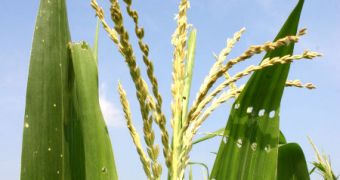When an ecosystem is threatened by drought, floods or warming, both animals and plant species tend to suffer. But, while animals can leave a certain area, and search for a new habitat, plants can obviously not. Researchers recently looked at the mechanisms they use to resist environmental challenges.
Because they can't simply uproot themselves and walk away, plants had to evolve another method of coping with change, and they chose to use genetics. Investigators say that manipulations of the genome allows vegetation to decide how to change its living patterns in accordance with their surroundings.
For example, genetics may be used to change the time of year when seeds are dispersed, or the way in which the leaves orient themselves in respect to the Sun. Gene manipulations can also allow plants to remain cooler or warmer during the day, and generally make the best of available conditions.
Without this ability, most plant species would die. The past five global extinction events would have left nothing behind, had plants not been able to adapt within the course of a few generations.
In the new study, experts at the Cold Spring Harbor Laboratory (CSHL) analyzed a particular species of grass, which needed to respond to its environment by growing in the shade. The team was able to identify the gene that allowed the plant to evolve.
Researchers say that the gene grassy tillers1 (gt1) is light-activated and that it plays an important role in numerous “genetic tricks” plants use. Interestingly, it also occurs in maize, which is one of the world's most important food crops.
Maize was domesticated for an unremarkable plant called teosinte. Through trial-and-error approaches, our ancestors managed to manipulate the plant so that it turned into a staple food. Traits such as being able to grow in close, straight rows and produce branchless stalks did not occur naturally.
“The domestication of maize from its wild ancestor teosinte resulted in a striking modification of the plant’s architecture, and this fact provided a starting point for our work,” David Jackson says.
He holds an appointment as a professor at CSHL and is also the leader of the research team. The group includes experts from the Cornell University, the University of Wisconsin-Madison, the North Carolina State University, the University of California in San Diego and Pioneer Hi-Bred.
Details of the new investigation appear in the August 1 early online issue of the esteemed journal Proceedings of the National Academy of Sciences (PNAS),
“It is actually human selection that has done this. Although maize plants produce tiller buds, the nascent branches fail to grow out, which results in the plant’s familiar dominant central stalk,” Jackson goes on to say.
“Tillering is an important trait in the grass family, and by modifying tiller production agriculturalists have increased yield in grasses such as maize and rice,” the investigator argues.
“Understanding the molecular mechanisms behind that modification may now provide us with a means to increase biomass production in switchgrass or other potential biofuel crops,” he concludes.
Funding for the research came from the US National Science Foundation (NSF) and the Department of Agriculture (USDA).

 14 DAY TRIAL //
14 DAY TRIAL //